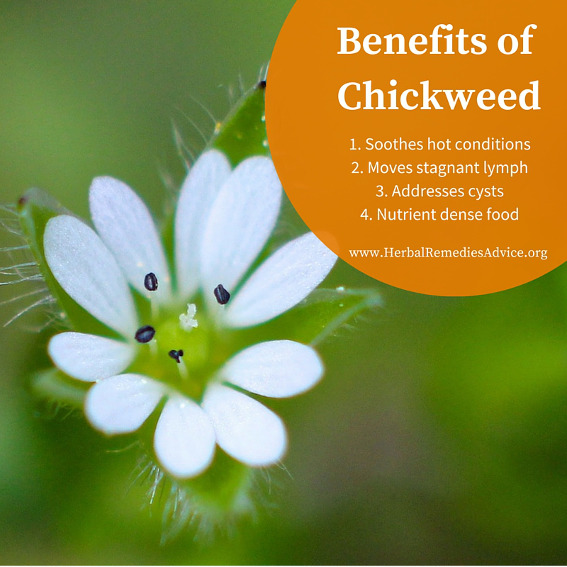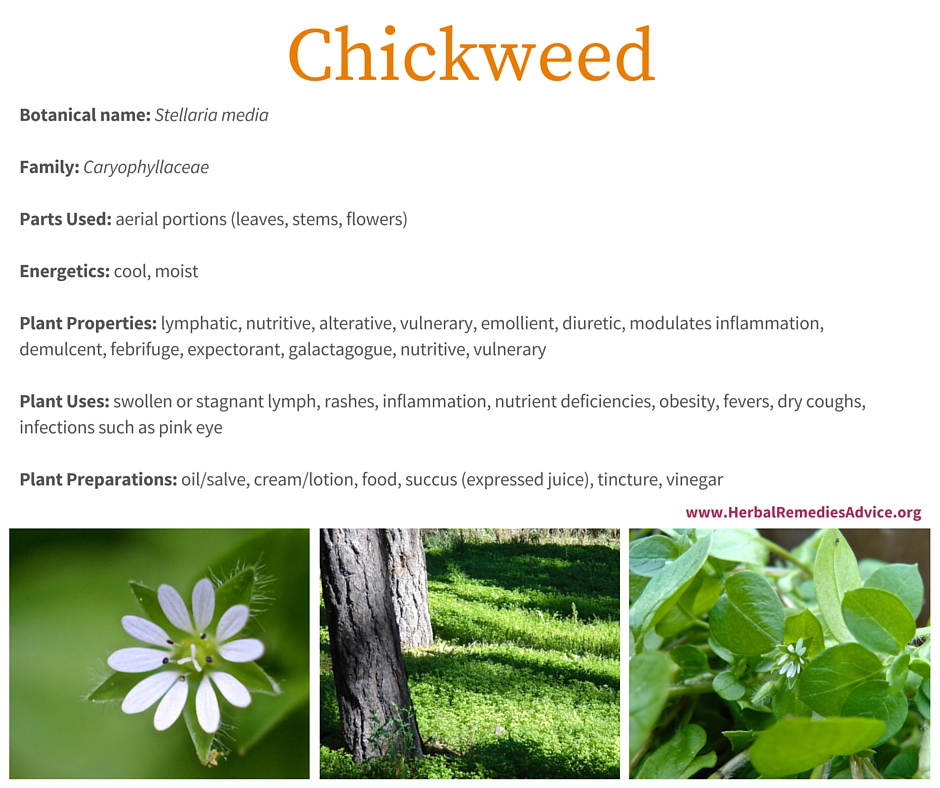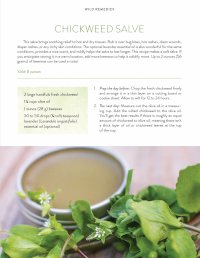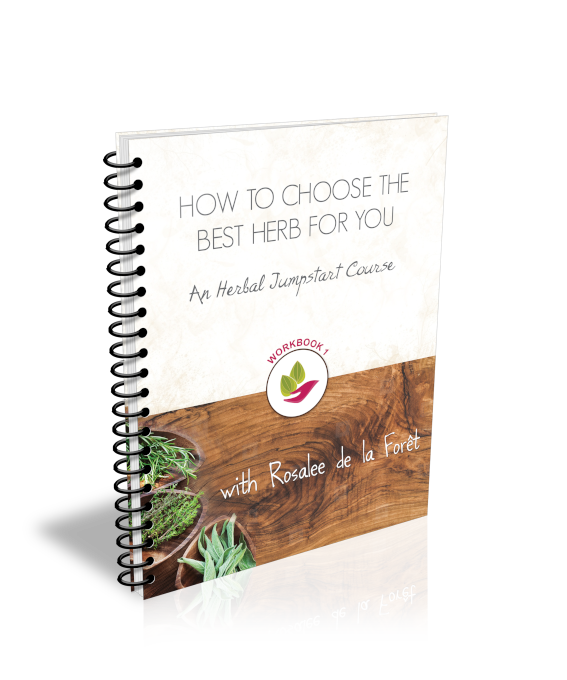Get weekly tips, recipes, and my Herbal Jumpstart e-course! Sign up for free today.

Chickweed Herb Uses
Share this! |
|
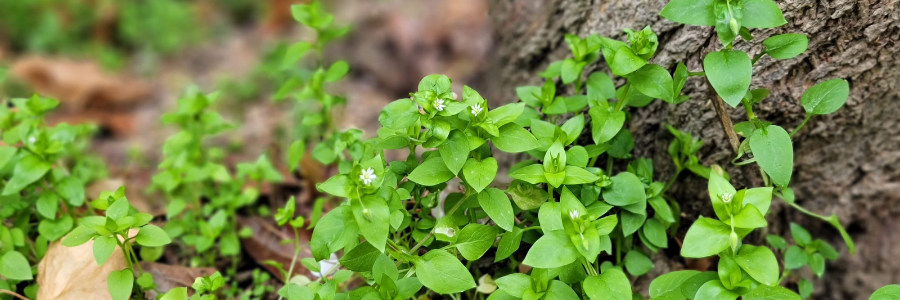
Chickweed, also known as Stellaria media, is a powerhouse of medicine and nutritious food! There are so many chickweed herb uses… for dry, irritated eyes; for the lymphatic and urinary systems; for coughs and fevers (but only certain types of coughs and fevers!).
And chickweed benefits the skin.
Imagine this… Your child comes in from playing outside with a bunch of itchy, red welts from bug bites. Ouch! But fear not.
By the end of this video, you’ll know how to make a chickweed salve that can help to soothe the heat and itchiness right out of that irritated skin.
Chickweed is an easy plant to welcome into your life, but you want to make sure you’re making the most of it. In this video, I’ll answer important questions like whether to work with it fresh or dried and I’ll share my best tips for chickweed identification. Be sure to stick around to the end to get my recipe and free recipe card for the chickweed salve.
-- TIMESTAMPS --
- 00:00 - Introduction to chickweed (Stellaria media)
- 03:55 - Nutrients and phytochemicals in chickweed
- 05:19 - Chickweed for the eyes
- 06:08 - Chickweed for the lymph
- 06:42 - Chickweed benefits for the skin and wounds
- 07:25 - Chickweed for coughs
- 08:24 - Chickweed for the urinary system
- 08:55 - Chickweed for fevers
- 09:17 - Chickweed identification (Stellaria media)
- 10:35 - How to work with chickweed
- 11:52 - Chickweed salve recipe
- 17:55 - Special considerations
- 19:21 - Chickweed Fun Fact
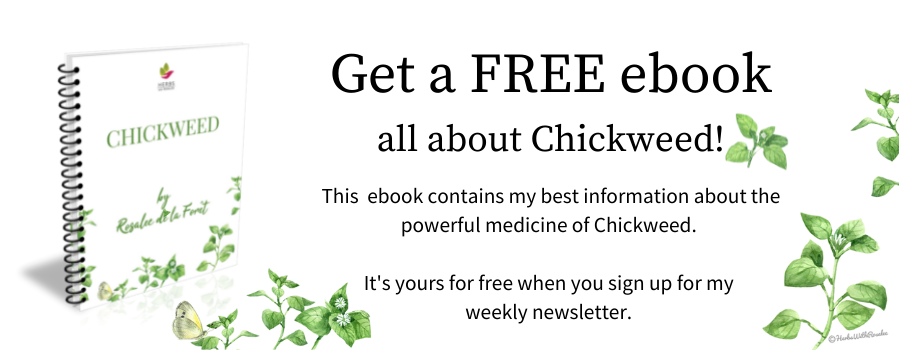
Transcript of the Chickweed Herb Uses Video
Is chickweed, also known as Stellaria media, popping up in your garden? Lucky duck! There are so many chickweed herb uses! If you’ve got this plucky weed in your life then you’ve got a powerhouse of medicine and nutritious food! I’m going to show you how to safely work with this important herb to get the most chickweed benefits and show you how to make a chickweed salve.
I absolutely adore chickweed! While some gardeners scorn its arrival in their garden, I do all that I can to give it a special space to grow! Chickweed is an easy plant to welcome into your life, but you want to make sure you are making the most of it. In this video I’ll answer important questions like whether to work with it fresh or dried and my best tips for chickweed identification. Be sure to stick around to the end to get my recipe and free recipe card for chickweed salve.
And, while you’re watching, let me know in the comments below about your experience with chickweed. It’s always interesting and insightful to hear the experiences of plant lovers out there. Your suggestion may also help others!
I’m not joking when I say I love chickweed. I recently returned from a trip to France and Ireland and, while most people return with photos of famous places or monuments, I lost count of how many chickweed photos I took! I’ll include some of those in this video.
Okay let’s dive in!
Chickweed is an opportunistic and nutrient-dense plant that offers soothing and cooling relief to many different symptoms of heat, dryness, and inflammation. Rather than simply memorizing chickweed herb uses, it’s especially helpful to understand this plant’s energetic profile and how it relates as a heating or cooling and drying or moistening herb.
My first book, Alchemy of Herbs, shows you exactly how to choose herbs that are best for you, based on herbal energetics. So if these concepts are new to you, check out that book to get a foundational understanding.
While chickweed is native to Europe, it has spread to many temperate parts of the world and is naturalized in North America. It loves cooler weather and is often one of the first plants to emerge in the spring. It disappears with the heat of the summer and, in some climates, returns in the cooler fall months.
Chickweed’s growing habit is indicative of its use as medicine. Chickweed loves cool moist weather and it is often indicated whenever we want to bring cooling and moistening relief to hot and dry tissues. While there are many nuances to understanding chickweed as medicine, if you only applied it energetically, as in using it as a cooling and moistening plant, you would be able to work with this little plant with lots of success.
Nutrients and Phytochemicals in the Herb Chickweed
Chickweed is high in many nutrients, including calcium, phosphorous, magnesium, potassium, and vitamin C. This nutritious and ubiquitous plant is recommended as a delicious wild edible and can be especially beneficial for those in recovery from illness or other nutrient depletion.
Chickweed helps the body absorb nutrients better. It is a safe and nourishing herb for a person of any age to take over several months when weak, chronically tired from overwork and stress, traumatized, anemic or recovering from a long-term illness or surgery. - Deb Soule, Herbalist 2
Chickweed is also high in saponins. When plants high in saponins are agitated in water, a visible soap-like foam appears. This foaming ability is caused by the interaction of fat-soluble and water-soluble constituents.
Saponins have a range of activity within the body. They can regulate blood sugar, support a healthy microbiome, and modulate inflammation.
Herbalists have long used chickweed to address infections. In-vitro studies have isolated various constituents in chickweed that have shown antiviral activities against HSV-2 and Hepatitis B. 2,3
Chickweed Herb Uses for the Eyes
Your eyes naturally like to be both cool and moist. The discomfort of redness, irritation, dryness, styes, and pink eye (conjunctivitis) can be soothed with chickweed. For best effect, mash up the fresh plant and apply the juicy pulp to a closed eye. After 10-20 minutes, or when the poultice becomes warm, remove the poultice and apply a fresh poultice of chickweed. For best results, this can be repeated multiple times and over the course of several days.
Here’s an important tip! Only use one poultice per eye, rather than switch the poultice from eye to eye.
Chickweed Herb Uses for the Lymph
Chickweed gently moves the lymph. Consider it when there are swollen lymph glands or when there is swelling and edema, indicating a stagnant interstitial fluid or lymphatic system.
Chickweed is also famously used for benign cysts. It can be used topically and frequently for common types of cysts, including ganglion cysts. Some herbalists recommend it internally for women with ovarian cysts. 4
Chickweed Herb Uses for the Skin and Wounds
Many hot or inflamed skin conditions are a good match for chickweed. Redness, irritation, and itchiness can be soothed with a topical poultice of the fresh plant. Herbalists report using chickweed successfully with eczema, boils, and many insect bites or stings, such as those of mosquitoes and bees.
Chickweed also calms angry red wounds, blisters, or scrapes, and is even said to pull out splinters. I especially love chickweed salve for itchy conditions. More on how to make that in just a bit.
Chickweed Herb Uses for Coughs
So far we’ve mainly discussed using chickweed topically for external signs of heat and irritation, but chickweed can also be used internally for the same types of symptoms. Dry and irritated lungs can result in spasmodic and unproductive coughs. In this case, the cough is actually a reaction to the irritated lung tissue. Chickweed can be used as a tincture, oxymel, or tea to restore moisture and bring cooling relief to the lungs.
Chickweed is also a mild expectorant and can help move mucus stuck in the lungs. This could be explained by the reflexive effects of saponin on the mucus membranes of the body. So if you have a dry irritated cough and you’ve got lots of chickweed growing near you, then simply reach out for this effective remedy from nature.
Chickweed Herb Uses for the Urinary System
Chickweed is a mild diuretic that helps to relieve signs of heat in the urinary system, such as frequent and painful urination. While not generally used as a simple for UTIs, it can be combined with other herbs such as Uva-ursi (Arctostaphylos uva-ursi) and Yarrow (Achillea millefolium) to address the irritation of bacterial infections in the urinary tract.
Chickweed Herb Uses for Fevers
Used as a febrifuge, chickweed can calm an excited fever or when someone feels hot and irritated. It’s not indicated when someone has a fever and also feels cold.
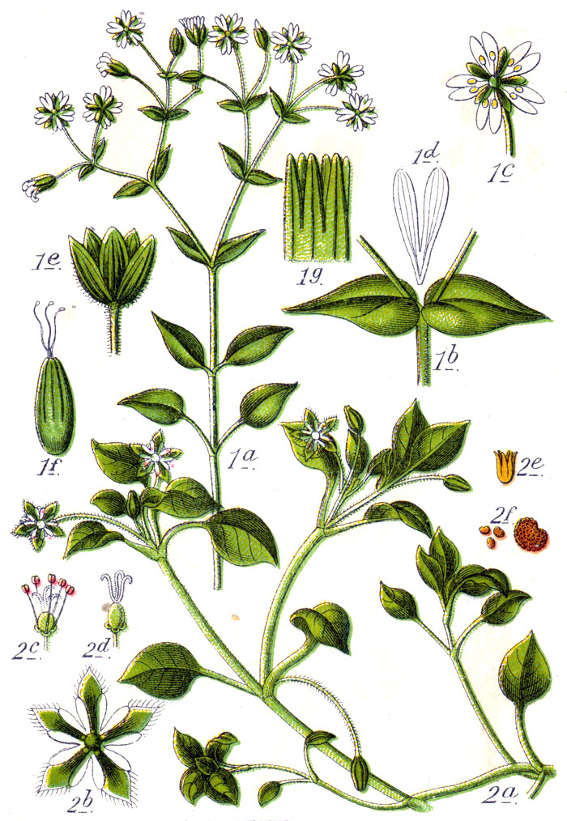
The Herb Chickweed
Chickweed is a low growing herbaceous plant that, in the right conditions, can form a thick mat along the ground. It thrives in cool and moist conditions and grows readily in disturbed soil.
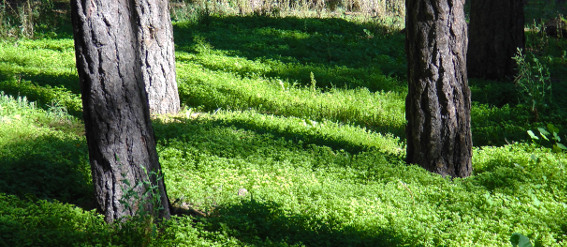
It has small white flowers with five sepals and five petals, which look like ten due to deep divides. Chickweed flowers are said to look like a star. The genus name, Stellaria, means star-like.
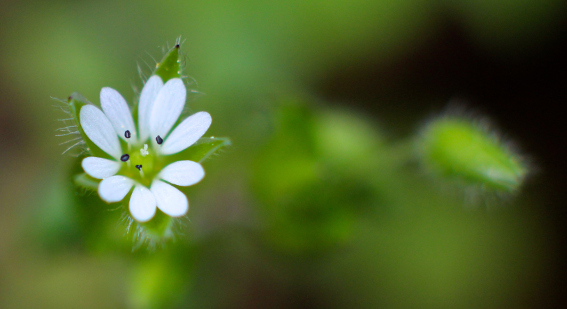
The leaves are oval shaped and grow opposite along the stem.
One distinguishing feature of chickweed is a row of tiny hairs that grow along the stem. With each leaf node the row of hairs shifts along the stem. (You may need a magnifier to clearly see these little hairs.)
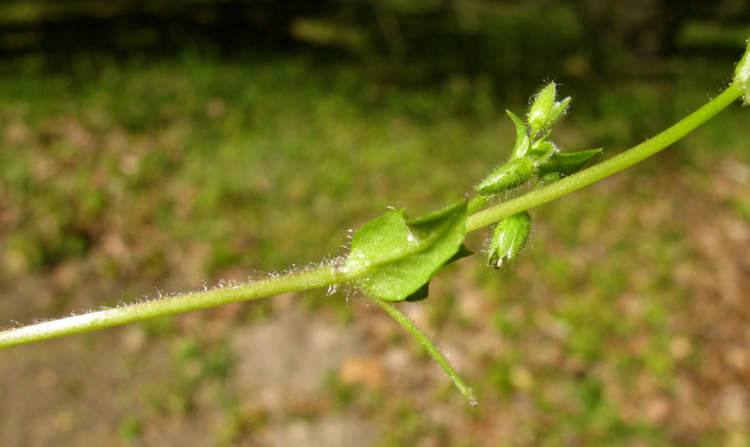
The roots are thin and shallow, making the plant easy to pull out from the earth. It re-seeds readily.
There are anywhere from 90-120 different species within the Stellaria genus.
Chickweed Herb Uses
Fresh is best when it comes to our starry friend. Chickweed can be dried, but you’ll notice its potency declines quickly over just a couple of weeks. If you want to dry it, use it up quickly and before its color turns from a vibrant green to a yellow hue.
Use scissors to harvest the young plant. It can be harvested while flowering, but avoid harvesting it if it has gone to seed as it becomes more tough and fibrous. Regularly harvesting chickweed will inspire it to branch and produce thick regrowth.
Chickweed can be eaten as a raw salad green or added to cooked foods. I love chickweed pesto! Make this as you would a basil pesto, simply substitute chickweed. Pre-chop the chickweed before adding it to the blender as the stems can become entangled around the blades. (See the full chickweed pesto recipe here!)
Use chickweed fresh to extract in alcohol or vinegar.
One of my favorite ways to work with chickweed is as a salve.
Chickweed Salve Recipe
There’s so much to love about chickweed salve. It’s safe, it’s very effective for a wide range of topical problems, and chickweed grows ubiquitously all over the globe. Chickweed salve is easy to make, but it does require a couple of days to complete the process.
This salve specifically brings soothing relief to hot and dry tissues. Rub it over bug bites, hot rashes, clean wounds, diaper rashes, or any itchy skin conditions. The optional lavender essential oil is also wonderful for the same conditions, provides a nice scent, and mildly helps the salve to last longer. This recipe makes a soft salve. If you anticipate storing it in a warm location, add more beeswax to help it solidify more. Up to 2 ounces (56 grams) of beeswax can be used in total.
This particular recipe comes straight from my second book, Wild Remedies: How to Forage Healing Foods and Craft Your Own Herbal Medicine. This book is perfect for you if you want to learn more about the plants growing near you. Included with each herbal chapter is safety information, sustainable harvest instructions and lots of fun and easy recipes like this one.
Special Considerations for the Herb Chickweed
Chickweed is both medicine and food. As a result, the “dosage” for it can be quite high when eaten as a vegetable.
Chickweed is a very safe herb. Because it is high in saponins, extremely large amounts of it may cause nausea or diarrhea in some people. As with any herb, start slowly with chickweed until you see how your body reacts. I’ve often eaten large salads made with raw chickweed and have never had a problem, but we all have different levels of sensitivity, so go slow to be safe.
Summary of Chickweed Herb Uses
Chickweed is a delicious and nutritive plant that brings cooling and moistening relief to hot and dry tissues, whether it’s an inflamed eye, itchy skin, or irritated lungs. This plant is best used when fresh. Luckily for us, it grows readily in cool moist locations in disturbed soils and flourishes when it is harvest regularly.
Citations for Chickweed Herb Uses
Click to show/hide.
Rosalee is an herbalist and author of the bestselling book Alchemy of Herbs: Transform Everyday Ingredients Into Foods & Remedies That Healand co-author of the bestselling book Wild Remedies: How to Forage Healing Foods and Craft Your Own Herbal Medicine. She's a registered herbalist with the American Herbalist Guild and has taught thousands of students through her online courses. Read about how Rosalee went from having a terminal illness to being a bestselling author in her full story here.
